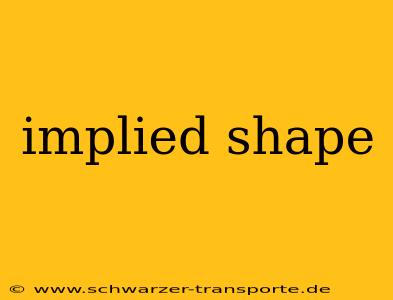Meta Description: Discover the power of implied shape! Learn how artists and designers create a sense of form and structure without explicitly defining outlines. Explore examples, techniques, and the impact of implied shapes on visual communication. Dive into the world of negative space, Gestalt principles, and more to master this crucial design element.
What is Implied Shape?
Implied shape, also known as suggested shape, is a powerful visual technique where an artist or designer creates the perception of a shape without actually drawing a complete, defined outline. It relies on the viewer's eye to connect the dots, filling in the gaps and perceiving a form that isn't explicitly stated. This is achieved through a variety of methods, creating a more dynamic and engaging visual experience than relying solely on explicitly drawn shapes.
Techniques for Creating Implied Shape
Several techniques contribute to the successful creation of implied shape:
1. Using Lines and Curves:
- Closed Lines: Nearly closed lines or partially defined outlines subtly suggest a complete shape. The viewer's mind automatically finishes the form.
- Implied Lines: A series of points, objects, or directional lines can create a path, leading the eye and implying a shape—think of a constellation forming a recognizable figure.
- Contour Lines: These lines follow the edges of a form, suggesting its shape even if not fully enclosed.
2. Negative Space:
- The Power of the Void: Negative space, the area surrounding an object, plays a crucial role. A well-placed negative space can define a shape as strongly as a solid outline. Think of the iconic FedEx logo—the negative space between the letters forms an arrow.
- Shape by Subtraction: Artists might use negative space to carve out a shape, implying its presence through what's not there.
3. Gestalt Principles:
- Proximity: Grouping elements close together creates a sense of unity, suggesting a shape formed by the clustered objects.
- Similarity: Similar elements, like color or shape, are perceived as belonging together, contributing to the implied shape of a larger group.
- Closure: The mind's tendency to complete incomplete figures is a cornerstone of implied shape.
4. Color and Value:
- Creating Contrast: Strategic use of light and shadow, color contrast, or value changes can suggest the form and volume of an implied shape. A darker area might imply a recessed portion of a shape.
- Gradients: Soft transitions of color or value can imply curved shapes or flowing forms, avoiding sharp, defined edges.
Examples of Implied Shape in Art and Design
Implied shape isn't just a theoretical concept; it's everywhere!
- Photography: A photographer might compose a scene to use negative space or suggest a shape through the arrangement of elements within the frame.
- Graphic Design: Logos often utilize implied shapes to create memorable and symbolic imagery (like the FedEx example above).
- Painting: Artists utilize implied shapes through brushstrokes, composition, and the interplay of light and shadow.
- Sculpture: The negative space around a sculpture can be just as important in defining its overall form and presence.
(Insert images here illustrating examples from each category above. Make sure to use descriptive alt text for each image, like "Example of implied shape in a photographic composition" or "Negative space defining a shape in a graphic design logo".)
Why Use Implied Shape?
Implied shapes offer significant advantages:
- Increased Visual Interest: They encourage active participation from the viewer, making the image more engaging.
- Subtlety and Nuance: They allow for a more sophisticated and less literal representation of form.
- Ambiguity and Depth: They can create a sense of mystery or allow for multiple interpretations.
- Modern and Minimalist Aesthetic: Implied shapes are frequently used in minimalist designs to create clean and uncluttered visuals.
How to Practice Creating Implied Shapes
Developing skill with implied shape takes practice and observation. Here are a few exercises:
- Study Masterworks: Analyze how famous artists and designers use implied shapes in their work. Pay attention to their techniques and the effect they achieve.
- Practice with Basic Shapes: Start by suggesting basic shapes (circles, squares, triangles) without explicitly outlining them.
- Experiment with Negative Space: Focus on using negative space to create compelling shapes.
- Sketch and Iterate: Don't be afraid to experiment and iterate on your designs, refining your use of lines, values, and negative space.
Conclusion: Mastering the Art of Suggestion
Implied shape is a fundamental design principle that adds dynamism, sophistication, and visual interest to any artwork or design. By understanding its underlying techniques and practicing its application, you can elevate your creative work to a new level. Mastering implied shape allows you to communicate effectively using suggestion and nuance, engaging viewers on a deeper, more interpretive level. So start experimenting—the possibilities are endless!
